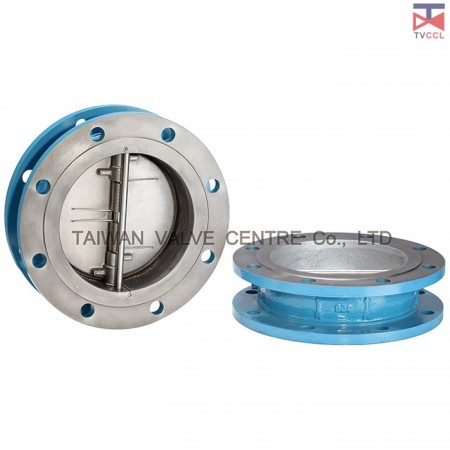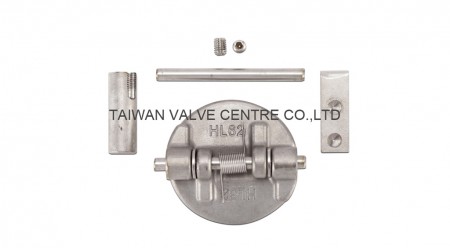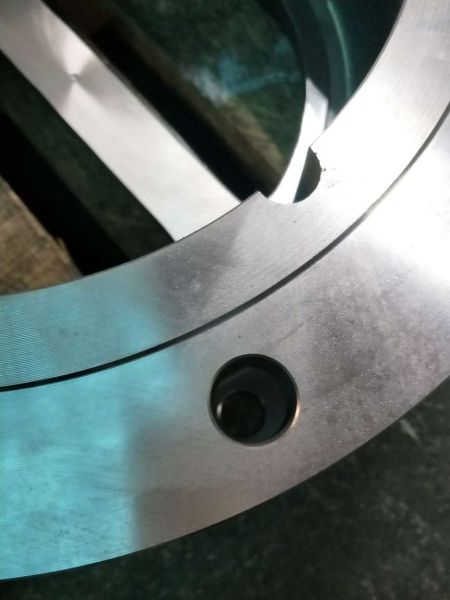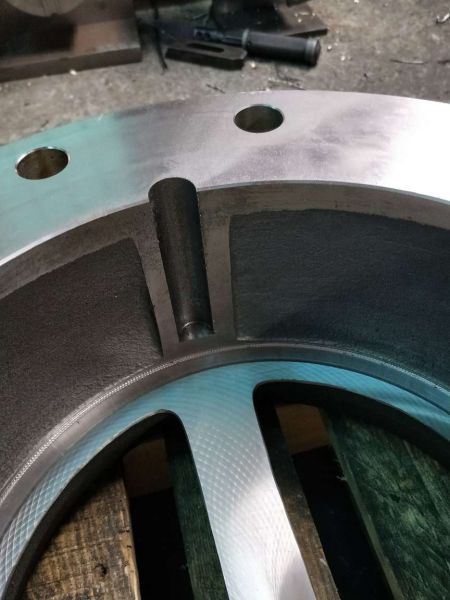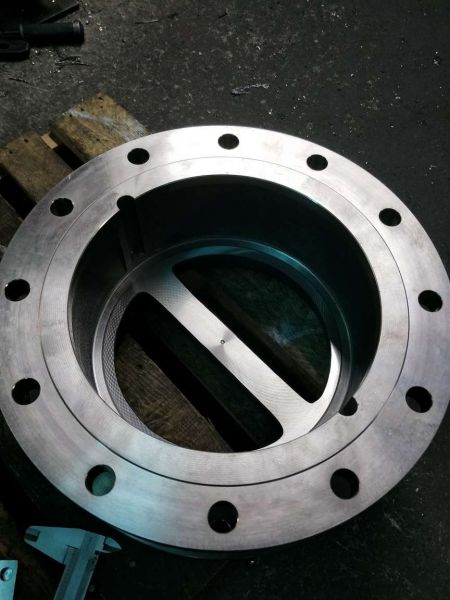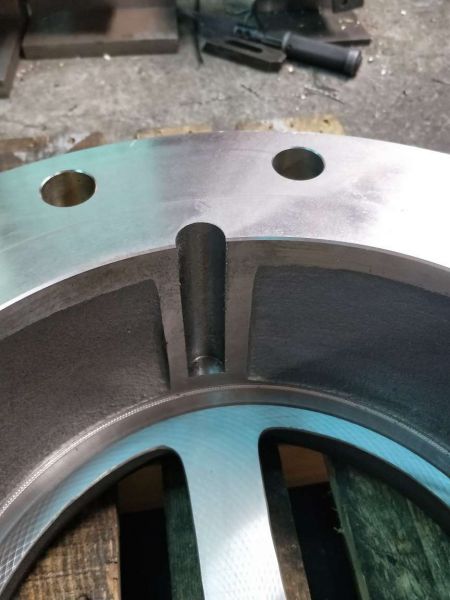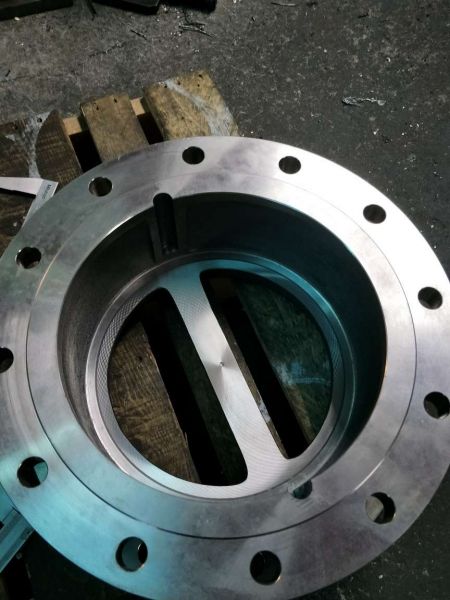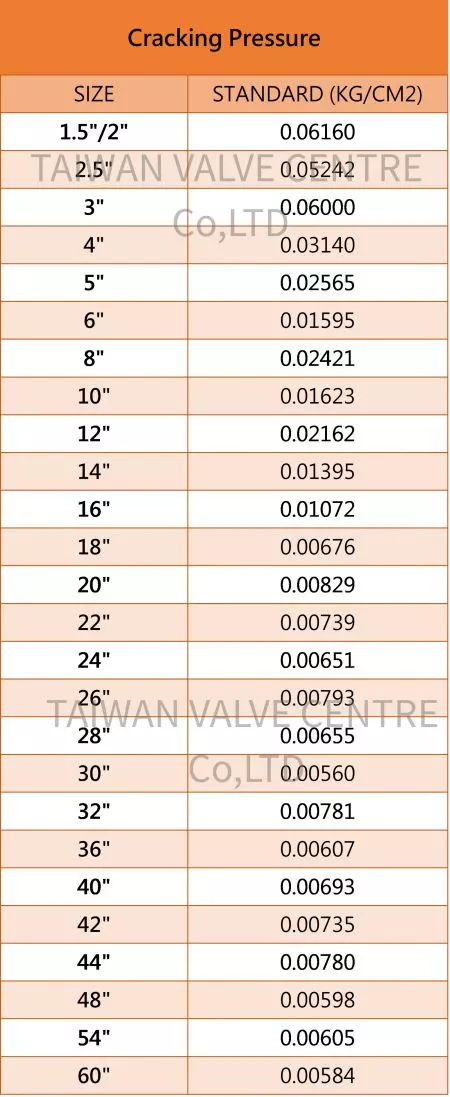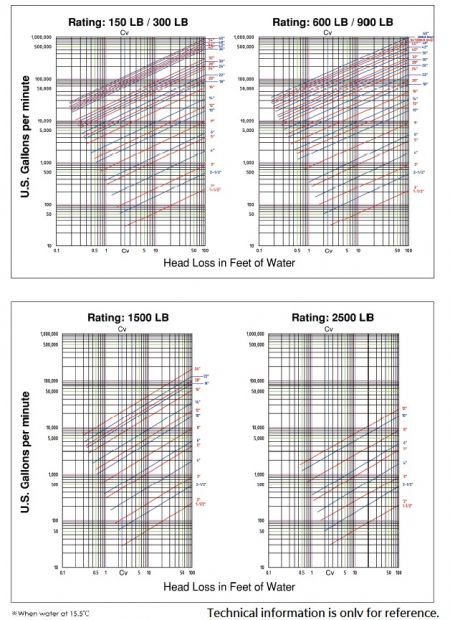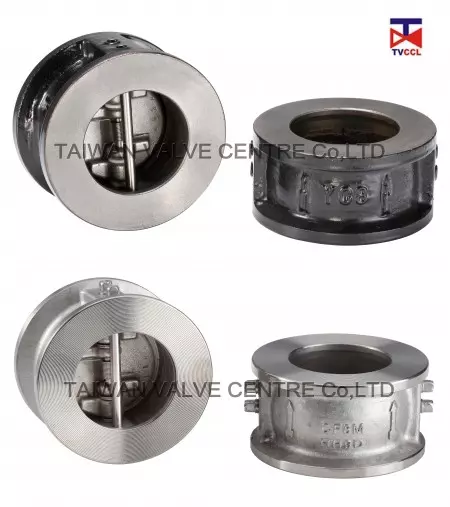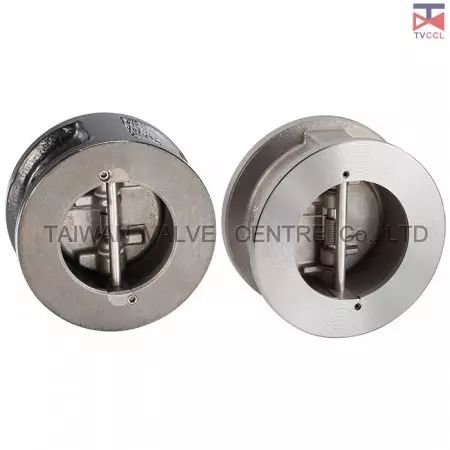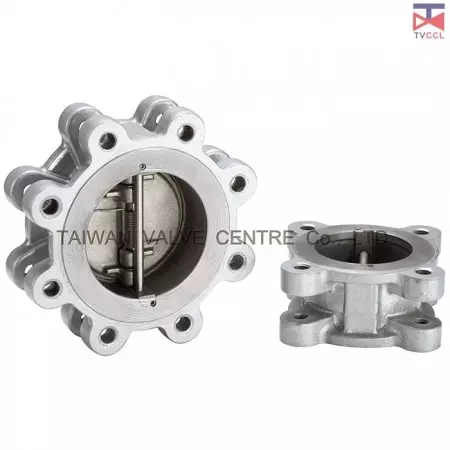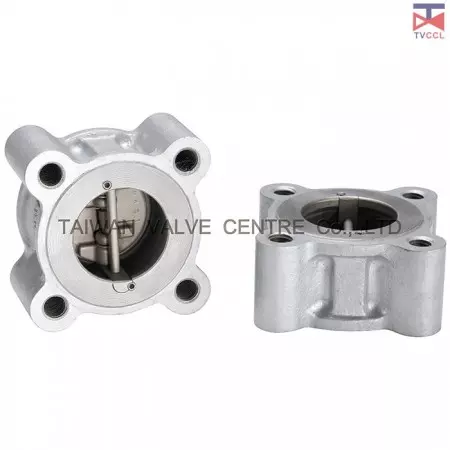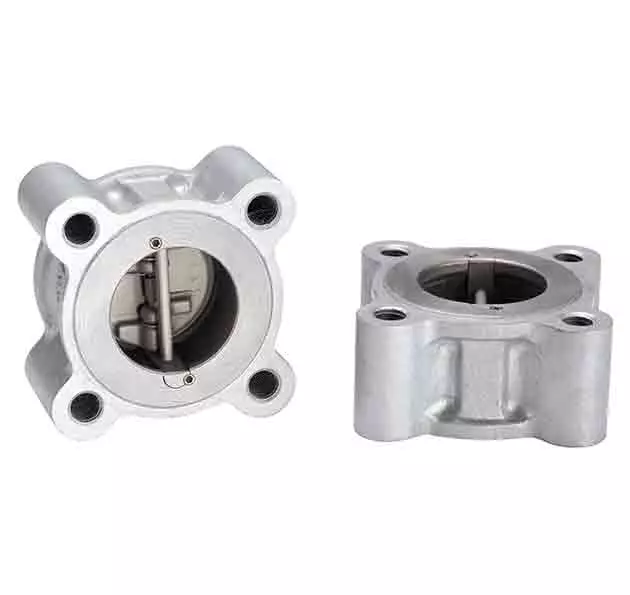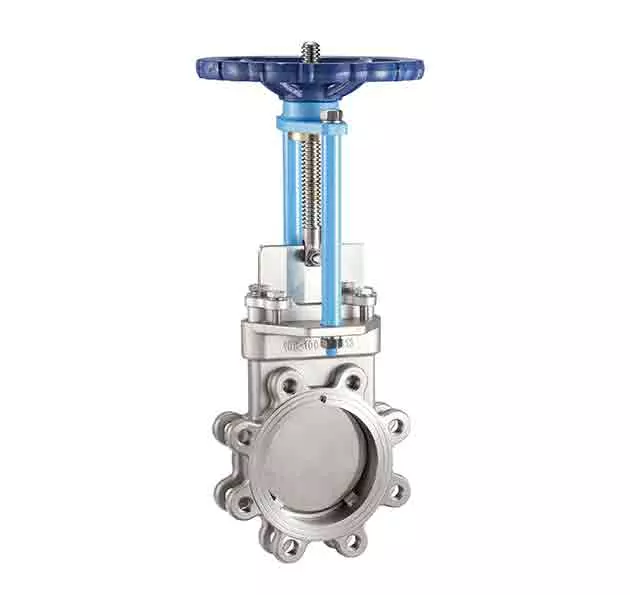Dual Plate Flange Type Check Valve With Retainerless
TC8-1
Flange retainerless dual check valve
Double Flange check valve with retainerless is designed to provide a cost-effective solution to your flow control and product shut-off requirements
Retainerless design flange type dual plate check valve suitable for use in countries with a lot of earthquakes or in environments where there will be vibrations.
Flange dual plate check valves with Retainerless have two plate in the body, work automatically and most are not controlled by a person or any external control.
Retainerless body twin disc flange type check Valve design with no external body penetrations eliminating the possibility of outside leakage.
Double flanged style twin door check valves bolt up similar to a bolted cap swing check or gate valve. Double flanged style twin door check valves versions are offered as standard on larger size valves where the lay length of the body permits installation of two heavy nuts between the flanges.
Flange connection is to two pipes, fittings or equipment before each fixed at a flange on the flange between the two, together with flange pad, fastened together with bolts to complete the connection. Some of pipe fittings and equipment have been built-flange, also falls within the flange connection.
Features
- Double flange design, install between pipe and flange by bolts and nuts, like dual plate wafer type check valve.
- Do not have any leakage problem on Body.
Dual Plate Check Valve Installation Guide:
When installing a check valve, it can be used in both indoor and outdoor environments. However, if the medium is corrosive or the surroundings are prone to rust, it is essential to select a valve material combination that matches the conditions to ensure durability and safety. For special operating conditions, it is recommended to consult TVCCL’s technical team for professional advice.
Before installation, all debris, oxidation scale, and solid impurities inside the pipeline should be thoroughly removed to prevent interference with the valve’s operation. During installation, the flow direction of the medium must align with the arrow marked on the valve body. The piping should be aligned at the front and rear centers, with flange interfaces kept parallel and bolts evenly tightened. Special attention should be paid to the distance between the check valve and the pump, which should be six to eight times the valve size to ensure stable system performance.
For routine maintenance, regular inspections should be conducted to check for leakage, abnormal noise, or vibration. In addition, the valve should be periodically examined for signs of corrosion, jamming, or other irregularities. Necessary cleaning, dust removal, and residue treatment should be performed to maintain proper equipment operation and extend its service life.
Specification
- Size: 12" ~ 60" (DN300 - DN1500)
- Pressure Rating For ASME: 125# ~ 2500# Suit For ASME / MSS / API Flange
- Pressure Rating For ISO: PN10 ~ PN40 Suit For ISO Flange
- Pressure Rating For JIS: 5K ~ 20K Suit For JIS Flange
- Material:WCB,CF8,CF8M,ALBC3,A8904A(MOQ)
- Designed in accordance with API 594
- End Connection: Wafer (TC8), Lugged (TC8-2, TC8-3)
- (Other flange connection please contact Taiwan Valves Centre Co., Ltd.)
- *Technical information is only for reference. Taiwan Valves Centre Co., Ltd. reserves the right to change without previous notice.
SELECTION GUIDE
1. Clarify Application Requirements and System Conditions
Begin by thoroughly assessing the environment in which the valve will operate. Key considerations include:
• Type of fluid — Is the medium water, oil, gas, slurry, or a corrosive chemical?
• Operating parameters — What are the system’s maximum pressure and temperature?
• Flow behavior — Is there a risk of sudden flow reversal or water hammer?
• Space limitations — Is the piping layout compact or spacious?
These factors help identify the most suitable valve materials and configurations for your system.
2. Select Materials Based on Fluid and Environment
The valve’s body and internal components must withstand corrosion and wear caused by both the fluid and the surrounding conditions. Common material choices include:
• Stainless steel — Excellent for corrosive or sanitary applications.
• Carbon steel or cast iron — Suitable for general-purpose use with non-aggressive media.
• PVC or engineered polymers — Ideal for low-pressure, non-corrosive systems.
Avoid incompatible combinations—such as using brass or mild steel with aggressive chemicals—as this may result in premature failure.
3. Choose the Correct Size and Pressure Rating
Valve sizing should align with the pipe diameter and expected flow rate:
• Proper sizing minimizes pressure drop and prevents turbulence.
• Ensure the valve’s pressure and temperature ratings exceed system requirements to maintain safety and reliability.
4. Evaluate Valve Dynamics and Performance Characteristics
Different wafer check valve designs offer distinct advantages depending on system demands:
• Spring-loaded or dual-plate wafer valves — Provide quick, silent closure to prevent water hammer in high-cycle operations.
• Standard single-plate models — Adequate for slow, steady flow in simpler systems
Seat Material Options for Dual Plate Check Valves
The seat of a dual plate check valve is available in a wide range of materials to meet various media properties, temperature ranges, and pressure conditions. Selecting the right seat material is essential to ensure reliable sealing performance, extended service life, and stable system operation.
Soft Seat Options:
Soft-seated designs provide excellent sealing performance and are typically made from rubber materials such as EPDM, NBR, or FKM (Viton®).
EPDM – Ideal for cooling water, potable water, and general water treatment applications.
NBR – Suitable for oils, air, and other neutral media.
FKM (Viton) – Offers superior resistance to high temperatures and aggressive chemicals, making it ideal for chemical and petrochemical industries.
Metal Seat Options:
For high-temperature, high-pressure, or abrasive conditions, metal seats are recommended to ensure enhanced durability and wear resistance.
Metal seats can be manufactured from the same material as the valve body or from stainless steels such as SS304, SS316, SS410, or hard alloys like Stellite 6. The allowable leakage rate for metal seats varies depending on valve size.
For any special rubber material requirements, please feel free to contact us.

HEAD LOSS
Head loss refers to the loss of a fluid’s total energy (or pressure) as it flows through pipelines or valves, caused by factors such as friction, turbulence, changes in flow direction, and resistance within the flow path. In a dual-plate check valve, head loss is the pressure drop that occurs when the fluid passes through the valve plates and internal structure.
The smaller the head loss, the lower the resistance the fluid encounters when passing through the valve, the higher the flow efficiency, and the less energy is dissipated. This reduces the system’s pumping energy consumption and improves overall operational efficiency. Conversely, larger head loss indicates greater flow resistance and requires the pump to expend more power to maintain the desired flow rate. Therefore, analyzing head loss data is an important step in valve selection to ensure system efficiency, pressure control, and economic performance.
Dual Plate Wafer Type Check Valve Operation
The dual plate check valve consists of a valve body, valve plates, stem, spring, and seat. It opens automatically under fluid pressure, allowing flow from the inlet to the outlet. When the inlet pressure drops below the outlet pressure, the valve plates close automatically due to the pressure differential and spring force, effectively preventing reverse flow.
This type of check valve is widely used in industries such as seawater desalination, shipbuilding, energy, water treatment, HVAC, and electronics. It serves as a safety device to prevent backflow and water hammer when pumps shut down, protecting the system from pressure surges and reverse rotation.
Advantages of Dual Plate Check Valves
Dual plate check valves offer several advantages that make them ideal for modern piping systems. Their compact and lightweight wafer design allows easy installation between flanges, saving both space and weight. The two spring-loaded plates close rapidly when flow decreases, effectively preventing backflow and minimizing water hammer.
Because of their simple structure and few internal components, dual plate check valves require minimal maintenance and provide reliable automatic operation without external power or manual control. They are available in a variety of materials and configurations, making them suitable for water treatment, HVAC, marine, power generation, and industrial fluid systems.
Functions of Dual Plate Check Valves
The primary function of a dual plate check valve is to prevent backflow and ensure that fluid flows in one direction only. Its two spring-loaded plates respond quickly to changes in flow, closing rapidly when flow reversal occurs to protect pumps, compressors, and other equipment from damage.
In addition to backflow prevention, dual plate check valves help maintain system pressure stability, minimize water hammer through non-slam operation, and improve overall energy efficiency. Their compact wafer-type design allows for easy installation and reliable performance across water treatment, HVAC, marine, power generation, and industrial pipeline systems.
Applications
- Flange retainerless dual check valve is suitable for high temperature and high pressure environment, like Petrochemical, Refinery or power plant.
- Flange dual plate check valves with Retainerless have two plate in the body, work automatically and most are not controlled by a person or any external control.
- Double Flange check valve is designed to provide a cost-effective solution to your flow control and product shut-off requirements
- Flange retainerless dual check valve is suitable for high temperature and high pressure environment, like Petrochemical, Refinery or power plant and Mineral-oil industry.
- Retainerless type dual plate flange-type check valve used in many general applications such as in water distribution, water treatment, dams, power plants and in many other.
- A double disc flange type check valve with retainerless suited for heavy duty services such as shipbuilding and wastewater plants.
- Dual disc flange type check valve with retainerless use for any industry concerned with fire hazards or environmental safety,also use for gases like Chlorine, Hydrogen, Nitrogen, Carbon Dioxide (Co ), Oxygen etc.
- Retainerless type with dual plate flange type check valve can be installed in heating air-conditioning pipe lines.
- Installed in hydrocarbon and chemical processing.
- Retainerless duo disc flange type check Valve also can be used in steam or vapor applications,Heating, air-conditioning, pipelines.
- Retainerless dual plate flange type check valve is a preferable option for highly toxic, corrosive, or hazardous gas chemical processing applications.
- Dual plate flange type check valve with retainerless applied in Iron and steel industry.
More Knowledge about TVCCL valve:
TVCCL Retainerless wafer check valve body features a single cast body without penetration through the body wall, eliminating the possibility of outside leakage; making it a preferable option for High-temperature work environment. Under the normal using situation, TVCCL guarantee retainerless type valve does not have any leakage problem on Body. Dual plate check valve with retainerless are available in 4 basic types: Wafer, Lug, Solid Lug, Flanged end, and in an extensive range of sizes, pressure classes and materials.
TVCCL check valve made of selected materials, each valve we made can offer the material certificate which according to BS EN 10204 3.1. Under the normal using situation, we can guarantee the TVCCL valve is more durable than the other manufacturers. And the performance is more reliable and practical. Using check valve under normal situation all can achieve the non-return effect. However, if the pipeline installation distance is less than 6~8 times the size of the valve, the life of the check valve may be shortened or the valve body and parts may be damaged.
More Knowledge about dual plate check valve:
Flange type retainerless type check valves are offered as standard on larger size valves where the lay length of the body permits installation of two nuts between the flanges. Flange type check valve is installed between two flanges using a separate set of bolts for each flange. This setup permits either side of the piping system to be disconnected without disturbing the other side. Flange Type Check Valve with two discs permits installation in a piping system in same manner as any conventional double flanged valve, i.e. studs and nuts per flange; this is one of the easiest connections to be installed or uninstalled from a pipeline. As Double flanged Type Check Valves are fastened to the pipe flanges, assembling or disassembling them is quick and easy. An important point to be mentioned about Double Flange types of end connections is that they are secured with several bolts. Flanged connections are the most common method of connecting valves, regardless of the pressure level (from low to high pressure levels) and valve size (from small to large valves). Flange dual plate check valves work automatically and it is not controlled by a person or any external control. Double flanged Type is offered as standard on larger size valves where the lay length of the body permits installation of two nuts between the flanges. Flange type valves are provided with thru-hole bolting in accordance with API 594, and if you have another standard demand, please send the inquiry to TVCCL. The Retainerless type is a type which body without pin retainer holes in the body. Retainerless type check valve use carrier and screw instead of retainer function to fix the pin. This design minimizes prospective leak paths through the valve body making it a preferable option for highly toxic, corrosive, or hazardous gas chemical processing applications. Retainerless valves are also suitable for high-temperature liquid, natural gas, steam service applications. Retainerless type check valve all inserts/parts are all the same as Dual plate check valve, except for using carrier and screw to replace the retainer. Simply, Dual plate check valve is drill four holes through the body of the check valve to facilitate installation of a hinge pin and stop pin, but Retainerless can be fixed by carrier and screw and is no need to drill the holes outside of valve’s body. Model: TC8 Wafer or Double Door Check Valves have no through holes. The Retainerless special to use in industry, especially offshore or onshore pipelines, there is a tremendous concern for fugitive emissions and potential environmental concerns. Retainerless check valve design also provides higher integrity on high pressure, ensuring no concerns about leakage.
- Related Products
Dual Plate Wafer Type Check Valve
TC0
Fast Delivery: Most orders are shipped within 3-7 days, depending on stock availability. Versatile...
DetailsDual Plate Wafer Type Check Valve With Retainerless
TC8
The dual disc check valve with its compact wafer design and low cost have made it a popular...
DetailsDual Plate Lug Type Check Valve With Retainerless
TC8-2
Dual plate lug type with retainerless check valve’s body features a single cast body without...
DetailsDual Plate Full Lug Type Check Valve With Retainerless
TC8-3
Full lug type dual Plate Check valve with retainerless series are more and more popular because...
Details- Files Download
- FAQ
Q.What Is Check Valve?
TVCCL Check Valve is a dual plate check valve that conforms to API 594. TVCCL is known as one of the leading manufacturers of Valve in Taiwan since we established.A...
Q. How Do Install Double Disc Check Valve In Pipe?
Taiwan Valve Centre Co.,Ltd. is the professional dual check valve manufacturers in the Taiwan. This information concerning the installation and operation...
Q. What Kind Of Material TVCCL Stock For Dual Check Valve?
Materials Stocked for Dual Plate Check Valve by TVCCLTVCCL, a pioneer in valve manufacturing, has been at the forefront of the industry since 1998. Our expertise...
Dual Plate Flange Type Check Valve With Retainerless - Flange retainerless dual check valve | Made in Taiwan Dual Plate Check Valves Manufacturer | Taiwan Valve Centre Co., Ltd.
Located in Taiwan since 1998, Taiwan Valve Centre Co., Ltd. has been a dual plate check valve manufacturer with all the valves sold to 1,500 clients in 80 countries worldwide. Their main valve products, including Dual Plate Flange Type Check Valve With Retainerless, dual plate check valves, dual plate full lining type, retainerless check valves, bypass check valves, short and long wafer check valves and spring wafer type for industries, such as oil, shipbuilding, seawater desalination, cooling system and nuclear.
TVCCL has a competitive pricing, reliable quality product and excellent after-sales support, well-down packing. We have received good reputation as being a well-known supplier in supplying reliable quality and competitive price check valves from customers. 20 years of experiences in producing dual plate check valve, excellent after-sales support, OEM / ODM, oil industry, shipbuilding, seawater desalination, cooling system, nuclear industry.
TVCCL, TAIWAN VALVE has been offering customers high-quality and durable industrial check valves for any applications since 1998, both with advanced technology and 25 years of experience, TVCCL, TAIWAN VALVE ensures each customer's demands are met.

